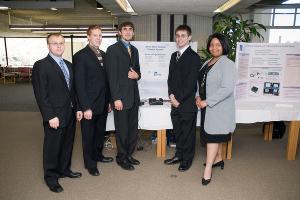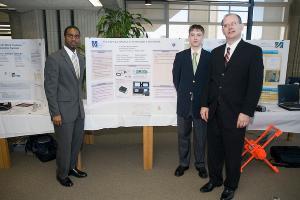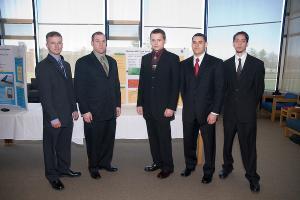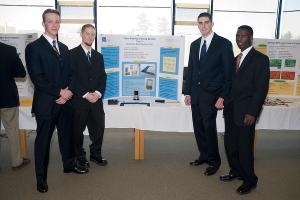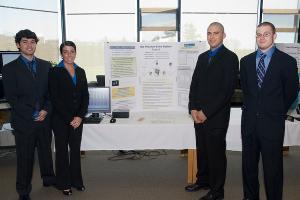2007
There were 27 students enrolled in ECE 457/458 Design Project I/II, the capstone design experience where students expand their abilities and develop important real world engineering problem solving skills. The students were divided into six groups. The details are given below.
| Project Title | |
|---|---|
| Group 1 | Aerial Wind Turbine Control System |
| Group 2 | Multiple Display Controller System |
| Group 3 | GPS Tracked Surface Drifters for Estuarine Research |
| Group 4 | Wireless MP3 Link Proof-of-Concept |
| Group 5 | Team Rowing Training System |
| Group 6 | Bat Phantom Echo System |
Group 1
Student Members:
Gary Albert
Kyle Fournier
Aleksander Groshev
Makia Powell
Phillip Smith
Faculty Advisor:
Dr. Paul Fortier
Project Title:
Aerial Wind Turbine Control System
Project Description:
The aerial wind turbine project has several aspects that need to be considered and several components that need to be designed. One major component of a wind turbine is the control system. The system is responsible for connecting and disconnecting a generator from a utility line, shutting down the turbine in high winds and controlling the orientation of the blades. Without proper timing a wind turbine will not be efficient and will not deliver power. Without protection from harmful winds the turbine generator would destroy itself. It is our goal "to design and test a control system that will automatically connect and disconnect the generator to the utility line, shut down the turbine in case of an equipment malfunction or in high winds. It must also enable a person to shut down the system, and place the system in readiness mode. In addition a web interface must be designed for the turbine to control, collect, store and display data relating to power output and important turbine functions."
Group 2
Student Members:
Thomas Bigelow
Carl Bernard
Michael Guilmette
Sean Leblanc
Faculty Advisor:
Dr. Luidong Xing
Project Title:
Multiple Display Controller System
Project Description:
Current Navy personnel work at a station that utilizes multiple displays interfaced to a single computer. The input device for this computer is a trackball rather than a standard mouse. When the user needs to move the mouse cursor between different displays, he rolls the cursor to the edge of the current display and it moves over to the next monitor. The problem is that the movement between monitors is not a seamless transition, and the user has to apply significant force to the trackball to move between screens. This causes the mouse cursor to move rapidly once it reaches the next display and the user loses track of the cursor. While this might not seem to be more than a minor inconvenience, after four or five hours of work at the station it becomes a significant problem. The Naval Undersea Warfare Center is looking to create a different method of moving the mouse cursor between displays. Specifically, a system is needed to move the mouse cursor between displays based on the movement of the individual's head.
Group 3
Student Members:
Timothy Butler
Douglas Caron
Daniel Forbes
Jim Mathew
Faculty Advisor:
Professor Robert Helgeland
Project Title:
GPS Tracked Surface Drifters for Estuarine Research
Project Description:
Dr. MacDonald of SMAST needs a system to track the movements of freshwater, from an estuary, into the coastal ocean as the tide ebbs. To achieve this goal, Dr. MacDonald will drop drifters into the water at the mouth of the estuary and track their movement over a period of time. In a previous attempt, he used handheld two-way radios, which had GPS capabilities. He placed one radio inside a drifter, and had another one on the deck of his research vessel. The radio, which he kept on the vessel, was capable of pinging the other radios and "asking" them where they were located. He recorded these locations and was able to record the movement of the freshwater currents. This method had a few downfalls. First, the time required to poll each drifter and record its location was fairly significant. In order to poll each drifter often enough, multiple people were required to operate the radios on the vessel. Second, the range of the handheld radios was not as far as Dr. MacDonald had hoped. Over the period of the study, many of the drifters exceeded the range of the handheld radios which caused the team to be unable to immediately retrieve the drifters. Our task is to build a new system that will allow Dr. MacDonald to record the currents and successfully retrieve the drifters for redeployment. Through conversations with Dr. MacDonald, the team has developed requirements that will form a successful design.
Group 4
Student Members:
Richard Frade
Gregory Franco
Timothy Jean
Christopher Landry
David Terk
Faculty Advisor:
Dr. Karen Payton
Project Title:
Wireless MP3 Link Proof-of-Concept
Project Description:
MP3 players are extremely popular portable audio devices. Those who own one want to listen to their personal playlists at all times, especially while driving their own vehicle. The problem with this is, not all car stereos have auxiliary inputs for MP3 players. Many companies have developed a solution to this problem by utilizing portable FM transmitters to transmit the audio signal to the vehicle's antenna. The downfall of all such designs is strict laws governing all unlicensed FM transmitters. These stringent FCC regulations constrain transmitter output power to an extremely small magnitude, which makes all existing FM transmitter designs inefficient and susceptible to interference. Wireless-Techniques have asked us to design a system that will improve upon current MP3 player FM designs.
Group 5
Student Members:
Douglas Harvey
Henry Mabwa
Antone Pinto
Kevin Walsh
Faculty Advisor:
Dr. Gilbert Fain
Project Title:
Team Rowing Training System
Project Description:
Our project involves the development of a system to measure the force output of the individual rowers on a rowing team. The data collected by these sensors must be stored in a removable storage device for the team to analyze their performance after training sessions. Using a computer interface, the system must be able to display an individual's performance relative to past performances as well as the individual's performance vs. other rowers. The lead rower sets the pace for the other rowers to follow, so the system shall have audible feedback to synchronized the four other rowers with the lead rower. The Rowing Team will have audible feedback via a speaker located next to the steered. this system will help rowers stay synchronized and increase the overall performance of the team as well as give feedback of each rower's performance after training sessions. The cost of the system may not exceed that of a comparable system for measuring individual running performance (i.e. Polar RS800sd Running Computer, $470), or a total cost of $2350 for five rowers. In addition, the system must be watertight and have a battery life of a least two hours.
Group 6
Student Members:
Daniel Aspesi
Boris Berdichevsky
Nicole Cabral
Matthew Lowe
William Schmidt
Faculty Advisor:
Dr. Gilbert Fain
Project Title:
Bat Phantom Echo System
Project Description
